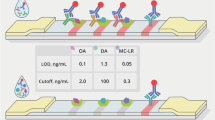Abstract
Ingestion of water contaminated with the cyanotoxin, microcystin (MC), can pose serious health risks to humans. MC is also known to accumulate in seafood; however, this exposure pathway is much less understood. A fundamental element of this uncertainty is related to analytical difficulties. Commercially available enzyme-linked immunosorbent assays (ELISAs) offer one of the best options for routine MC detection, but methods of detecting MC in tissue are far from standardized. We spiked freshwater finfish and marine mussel tissues with MC, then compared recovery rates using four different preparation protocols and two ELISA types (polyclonal anti-MC-ADDA/direct monoclonal (DM)). Preparation protocol, type of ELISA, and seafood tissue variety significantly affected MC detection. This is the first known study to use DM ELISA for tissue analyses, and our findings demonstrate that DM ELISA combined with a short solvent extraction results in fewer false positives than other commonly used methods. This method can be used for rapid and reliable MC detection in seafood.


Similar content being viewed by others
References
Adamovsky, O., Kopp, R., Hilscherová, K., Babica, P., Palíková, M., Pašková, V., Navrátil, S., Maršálek, B., & Bláha, L. (2007). Microcystin kinetics (bioaccumulation and elimination) and biochemical responses in common carp (Cyrpinus carpio) and silver carp (Hypophthalmichthys molitrix) exposed to toxic cyanobacterial blooms. 2007. Environmental Toxicology, 26(12), 2687–2693.
Babica, P., Kohoutek, J., Bláha, L., Adamovský, O., & Maršálek, B. (2006). Evaluation of extraction approaches linked to ELISA and HPLC for analyses of microcystin-LR, -RR and -YR in freshwater sediments with different organic material contents. Analytical and Bioanalytical Chemistry, 385, 1545–1551.
Berry, J. P., Lee, E., Walton, K., Wilson, A. E., & Bernal-Brooks, F. (2011). Bioaccumulation of microcystins by fish associated with a persistent cyanobacterial bloom in Lago de Patcuro (Michoacan, Mexico). Environmental Toxicology and Chemistry, 30(7), 1621–1628.
Chorus, I., & Bartram, J. (1999). Toxic cyanobacteria in water: a guide to their public health consequences, monitoring and management. London: E & F Spon.
Crawley, M. J. (2005). An introduction to statistics in R. New York: Wiley.
Deblois, C. P., Aranda-Rodriguez, R., Giani, A., & Bird, D. F. (2008). Microcystin accumulation in liver and muscle of tilapia in two large Brazilian hydroelectric reservoirs. Toxicon, 51, 435–448.
Dörr, F. A., Pinto, E., Soares, R. M., & Azevedo, S. M. F. O. (2010). Microcystins in South American aquatic ecosystems: occurrence, toxicity and toxicological assays. Toxicon, 56, 1247–1256.
Ernst, B., Dietz, L., Hoeger, S. J., & Dietrich, D. R. (2005). Recovery of MC-LR in fish liver tissue. Environmental Toxicology, 20(4), 449–458.
Fisher, W. J., Garthwaite, I., Miles, C. O., Ross, K. M., Aggen, J. B., Chamberlin, A. R., Towers, N. R., & Dietrich, D. R. (2001). Cogener-independent immunoassay for microcystins and nodularins. Environmental Science and Technology, 35, 4849–4856.
Geis-Asteggiante, L., Lehotay, S. J., Fortis, L. L., Paoli, G., Wijey, C., & Heinzen, H. (2011). Development and validation of a rapid method for microcystin in fish and comparing LC-MS/MS results with ELISA. Analytical and Bioanalytical Chemistry, 401, 2617–2630.
Gkelis, S., Lanaras, T., & Sivonen, K. (2006). The presence of MCs and other cyanobacterial bioactive peptides in aquatic fauna collected from Greek freshwaters. Aquatic Toxicology, 78, 32–41.
Hothorn, T., Bretz, F., & Westfall, P. (2008). Simultaneous inference in general parametric models. Biometrical Journal, 50(3), 346–363.
Kagalou, I., Papadimitriou, T., Bacopoulos, V., & Lenordos, I. (2008). Assessment of microcystins in lake water and the omnivourous fish (Carassius gibelio, Bloch) in Lake Pamvotis (Greece) containing dense cyanobacterial bloom. Environmental Monitoring and Assessment, 137, 185–195.
Kankaanpää, H. T., Holliday, J., Schröder, H., Goddard, T. J., von Fister, R., & Carmichael, W. W. (2005). Cyanobacteria and prawn farming in northern New South Wales Australia-a case study on cyanobacteria diversity and hepatotoxin bioaccumulation. Toxicology and Applied Pharmacology, 203, 243–256.
Kankaanpää, H. T., Leiniö, S., Olin, M., Sjövall, O., Meriluoto, J., & Lehtonen, K. K. (2007). Accumulation and depuration of cyanobacterial toxin nodularin and biomarker responses in the mussel Mytilus edulis. Chemosphere, 68, 1210–1217.
Kohoutek, J., Adamovský, O., Oravec, M., Simek, Z., Paliková, M., Kopp, R., & Bláha, L. (2010). LC-MS analyses of microcystins in fish tissues overestimate toxin levels-critical comparison with LC-MS/MS. Analytical and Bioanalytical Chemistry, 398, 1231–1237.
Kutner, M. H., Nachtsheim, C. J., & Neter, J. (2004). Applied linear regression models. New York: McGraw-Hill/Irwin.
Magalhães, V. F., Soares, R. M., Azevedo, S. M. F. O. (2001). Microcystin contamination in fish from the Jacarepagua Lagoon (Rio de Janeiro,Brazil): ecological implication and human health risk. Toxicon, 39, 1077–1085.
Malbrouck, C., Trausch, G., Devos, P., & Kestemont, P. (2003). Hepatic accumulation and effects of MC-LR on juvenile goldfish Carassius auratus L. Comparative Biochemistry and Physiology, 135(C), 39–48.
McCullagh, P., & Nelder, J. A. (1989). Generalized linear models. London: Chapman and Hall.
McEliney, J., & Lawton, L. A. (2004). Detection of the cyanobacterial hepatotoxins microcystins. Toxicology and Applied Pharmacology, 203, 219–230.
Mekebri, A., Blondina, G. J., & Crane, D. B. (2009). Method validation of microcystins in water and tissue by enhanced liquid chromatography tandem mass spectrometry. Journal of Chromatography A, 1216(15), 3147–3155.
Meriluoto, J. A. O., Spoof, L. E. M. (2007) Cyanotoxins: sampling, sample processing and toxin uptake. In H.K. Hudnel (Ed.) Cyanobacterial harmful Algal Blooms State of the Science and Research Needs (pp.483-499). New York: Springer Press.
Meriluoto, J. A. O., & Spoof, L. E. M. (2008). Cyanotoxins: sampling, sample processing and toxin uptake. In H. K. Hudnel (Ed.), Cyanobacterial harmful algal blooms state of the science and research needs, vol. 619, chapter 21 (pp. 317–381). New York: Springer Press.
Metcalf, J. S., Beattie, K. A., Pflugmacher, S., Codd, G. A., (2000). Immuno-crossreactivity and toxicity assessment of conjugation products of the cyanobacterial toxin, microcystin-LR. FEMS Microbiology Letters, 189, 155–158.
Mohamed, Z. A., Carmichael, W. W., & Hussein, A. A. (2003). Estimation of microcystins in the freshwater fish Oreochromis niloticus in an Egyptian fish farm containing a Microcystis bloom. Environmental Toxicology, 18, 137–141.
Mol, H., Plaza-Bolaños, P., Zomer, P., de Rijk, T.C., Stolker, A., Mulder, P. (2008). Toward a generic extraction method for simultaneous determination of pesticides, mycotoxins, plant toxins and veterinary drugs in feed and food matrixs. Analytical Chemistry, 80, 9450-9459.
Moreno, I. M., Herrador, M. A., Atencio, L., Puerto, M., González, A. G., & Cameán, A. M. (2011). Differentiation between microcystin contaminated and uncontaminated fish by determination of unconjugated MCs using an ELISA anti-Adda test based on receiver-operating character curves threshold values: application to Tinca tinca from natural ponds. Environmental Toxicology, 26(1), 45–56.
Paerl, H. W., & Huisman, J. (2009). Climate change: a catalyst for global expansion of harmful cyanobacterial blooms. Environmental Microbiology Reports, 1, 27–37.
Papadimitriou, T., Kagalou, I., Bacopoulos, V., & Leonardos, I. D. (2009). Accumulation of microcystins in water and fish tissues: an estimation of risks associated with microcystins in most of the Greek lakes. Environmental Toxicology, 25, 418–427.
Papadimitriou, T., Kagalou, I., & Leonardos, I. D. (2012a). Seasonally accumulation of microcystins in the various tissues of an endemic and protected fish species (Rutilus panosi) with different sizes. Clean - Soil, Air, Water, 40(4), 402–407.
Papadimitriou, T., Kagalou, I., Stalikas, C., Pilidis, G., & Leonardos, I. D. (2012b). Assessment of microcystin distribution and biomagnification in tissues of aquatic food web compartments from a shallow lake and evaluation of potential risks to public health. Ecotoxicology, 2, 1155–1166.
Poste, A. E., Hecky, R. E., & Guildford, S. J. (2011). Evaluating microcystin exposure risk through fish consumption. Environmental Science and Technology, 45, 5806–5811.
Romo, S., Fernández, F., Ouahid, Y., & Barón-Sola, Á. (2012). Assessment of microcystins in lake water and fish (Mugilidae, Liza sp.) in the largest Spanish coastal lake. Environmental Monitoring and Assessment, 184, 939–949.
Sipiä, V. O., Lahti, K., Kankaanpää, H. T., Vuorinen, P. J., & Meriluoto, J. A. O. (2002). Screening for cyanobacterial hepatotoxins in herring and salmon from the Baltic Sea. Aquatic Ecosystem Health and Management, 5(4), 451–456.
Smith, J. L., & Boyer, G. L. (2009). Standardization of MC extraction from fish tissues: a novel internal standard as a surrogate for polar and non-polar variants. Toxicon, 53, 238–245.
Smith, J. L., & Haney, J. F. (2006). Foodweb transfer, accumulation, and depuration of microcystins, a cyanobacterial toxin, in pumpkinseed sunfish (Lepomis gibbosus). Toxicon, 48, 580–589.
Soares, R. M., Magalhães, V. F., Azevedo, S. M. F. O. (2004). Accumulation and depuration of microcystins (cyanobacteria hepatotoxins) in Tilapiarendalli (Cichlidae) under laboratory conditions. Aquatic Toxicology, 70, 1–10.
Uneo, Y., Nagata, S., Tsutsumi, T., Hasegawa, A., Watanabe, M. F., Park, H. D., Chen, G. C., Chen, G., & Yu, S. Z. (1996). Detection of MCs, a blue-green algal hepatotoxin, in drinking water sampled in Haimen and Fusui, endemic areas of primary liver cancer in China, by highly sensitive immunoassay. Carcinogenesis, 17, 1317–1321.
Vareli, K., Zarali, E., Zacharioudakis, G. S. A., Vagenas, G., Varelis, V., Pilidis, G., Briasoulis, E., & Sainis, I. (2012). Microcystin producing cyanobacterial communities in Amvrakikos Gulf (Mediterranean Sea, NW Greece) and toxin accumulation in mussels (Mytilus galloprovincialis). Harmful Algae, 15, 109–118.
World Health Organization (2003). Guidelines for Safe Recreational Water Environments; Coastal and Fresh Waters. Vol. 1, (p.219). Geneva: WHO.
Wilson, A. E., Gossiaux, D. C., Höök, T. O., Berry, J. P., Landrum, P. F., Dyble, J., & Guildford, S. J. (2008). Evaluation of the human health threat associated with the hepatotoxin MC in the muscle and liver tissues of yellow perch (Perca flavescens). Canadian Journal of Fisheries and Aquatic Sciences, 65, 1487–1497.
Wood, S. A., Briggs, L. R., Sprosen, J., Ruck, J. G., Wear, R. G., Holland, P. T., & Bloxham, M. (2006). Changes in concentrations of MCs in rainbow trout, freshwater mussels, and cyanobacteria in Lakes Rotoiti and Rotoehu. Environmental Toxicology, 21, 205–222.
Xie, L. Q., Xie, P., Guo, L. G., Li, L., Miyabara, Y., & Park, H. D. (2005). Organ distribution and bioaccumulation of microcystins in freshwater fish at different trophic levels from the eutrophic Lake Chaohu, China. Environmental Toxicology, 20, 293–300.
Acknowledgments
This research was supported by grants from the U.S. Environmental Protection Agency’s Science to Achieve Results (STAR) program and the Confederated Tribes of the Colville Reservation. We thank Scott Mattinson and Lee Deobald for laboratory assistance and helpful discussions.
Author information
Authors and Affiliations
Corresponding author
Rights and permissions
About this article
Cite this article
Preece, E.P., Moore, B.C., Swanson, M.E. et al. Identifying best methods for routine ELISA detection of microcystin in seafood. Environ Monit Assess 187, 12 (2015). https://doi.org/10.1007/s10661-014-4255-y
Received:
Accepted:
Published:
DOI: https://doi.org/10.1007/s10661-014-4255-y




